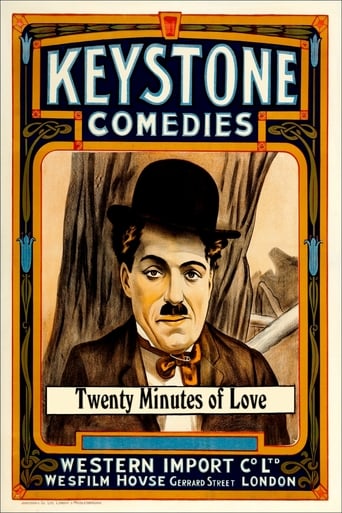Lee Eisenberg
Charlie Chaplin's directorial debut casts him as a man who interrupts people's makeout sessions in a park. There were no feature films by this point, so it makes sense that the movie has a simple plot. It was still going to be a few years before Chaplin started incorporating political issues into his movies. Chaplin's early movies were all about physical comedy, and he makes good use of that here. Co-star Edgar Kennedy (the lover) later played the lemonade vendor in "Duck Soup", while Chester Conklin (the pickpocket) played a mechanic in "Modern Times".It must've been weird for Charlie Chaplin, how he went from being a boy growing up in an orphanage to being an international superstar.
Jay Raskin
Because of their improvisational style there are often confusions in Keystone films, but this one has far more than average, both on screen and off.First there is confusion over who is the director. Maddern gets listed on the camera reports, but Maddern was only with Keystone for a month. At least 3 of his 4 other movies were documentaries, and the fourth is unknown. Chaplin, in a letter, a few months later to his brother Sidney, has the words "my own" next to this one in a list of his films. This might mean that he came up with the idea for the film rather than that he directed it. If he really directed it, One would expect him to list it as his first film in his autobiography, but he lists "Caught in the Rain" filmed a few weeks later. Maddern may have just set up the camera and let the actors direct themselves. This may have caused Chaplin to later take credit for it. Since nothing else remains of Maddern's oeuvre, it is impossible to know for sure who deserves credit or blame for this.In the very first shot, Chaplin walks towards the camera, but turns around to shout something at somebody he has just left behind. Who is he talking to? What is he talking about? The film leaves it a dead issue, but one has to suspect that elements of plot, and perhaps important ones were cut out before this first shot.Chaplin sees Edgar Kennedy and Minta Durfee making out on a park bench. Does Chaplin know Durfee? He turns and hugs the tree next to him. Is it because he has known Durfee and lost her or is he just love sick in general? It is impossible to know. If he did know Durfee before, his next action would make more sense. He goes to the park bench and observes Durfee and Kennedy kissing from inches away. He starts to hold Durfee's hand. If Chaplin doesn't know her, this is quite perverse. If he does know her, shouldn't she have more of a reaction. One should probably blame this on bad direction, whoever the director was.A few moments later, Chaplin follows Eva Nelson behind some bushes. He finds a couple sitting near the river. Again Chaplin goes up and looks at them as if he knows them, but the man only responds by knocking Chaplin down. This is another moment where the actor and audience don't seem to know what is going on. It suggests to me that something was cut out.At this point, we get a new beginning with Eva Nelson asking her boyfriend Chester Conklin (without his trademark Walrus mustache) to get her a present. He goes off and pickpockets a watch. Before he can give it to her, Chaplin, doing a Ford Sterling impression from the movie "Between Showers" steals the watch.Some good slapstick between Conklin, Durfee and Chaplin make up a bit for the plot inconsistencies. At least this middle section of the film has a clear plot and actions. Still, one would like to know why Chaplin steals the watch a second time after giving it to Durfee to show his love. Does this prove that he really is a pickpocket after all and the love show for Durfee was just an act? Again we get confused or unclear motivations that the audience can only guess at.The ending is the usual keystone chaos breaks loose type, with Chaplin kicking cops into people and lots of bodies flying into the river.While not without some moments of fun, Chaplin's eleventh film does not resonate and I would put it near the bottom of his Keystone work. The films he did just before and after this one, "Mabel Takes the Wheel" and "Caught in a Cabaret," in contrast go to the top. These Mabel Normand directed films are terrific.
CitizenCaine
Historically noted as Chaplin's directing debut, the film does move more evenly and quicker than most of his earlier efforts. The film involves Chaplin as a troublemaker in a park. He seems to keep running across secluded lovers on park benches. Throw in a pickpocket and a keystone cop and the makings of a terrific slapstick ending is predictable. Highlights are Chaplin's mannerisms, his scene with the tree (mocking the lovers) early in the film, and of course the obligatory slapstick fighting that occurs at the end involving everyone in the cast. The film itself is still nothing much more than Chaplin finding his way as a filmmaker; however, when compared to other films of the year, it does stand out as being better paced and edited. ** of 4 stars.
Matt Barry
As with any of Chaplin's films, this must be seen. Its title could've been "20 MINUTES OF LAUGHS," as that's just what this film supplies!


